Vibrant and colorful. Folk dances in Indian states are India’s identity in a way. India is a land of the most diverse cultures and traditions in the world. Be it a folk, classical or any other style, India has a wide range of dance forms. In a country, where dialect and food changes every 100 km, how could the folk dances remain the same?
So folks dances in India also change in style, dress, artists, music, folklore etc. India has dances for four different seasons as well. There is at least one dance in almost every state for the harvest time. These folk dances have evolved with time and depict expressions of happiness, sorrow, devotion, discipline and different moods and emotions of the society. Some of them also teach us a lesson. But all of them showcase the life in different forms of Indian culture.
Folk Dances of Assam
Bihu Dance
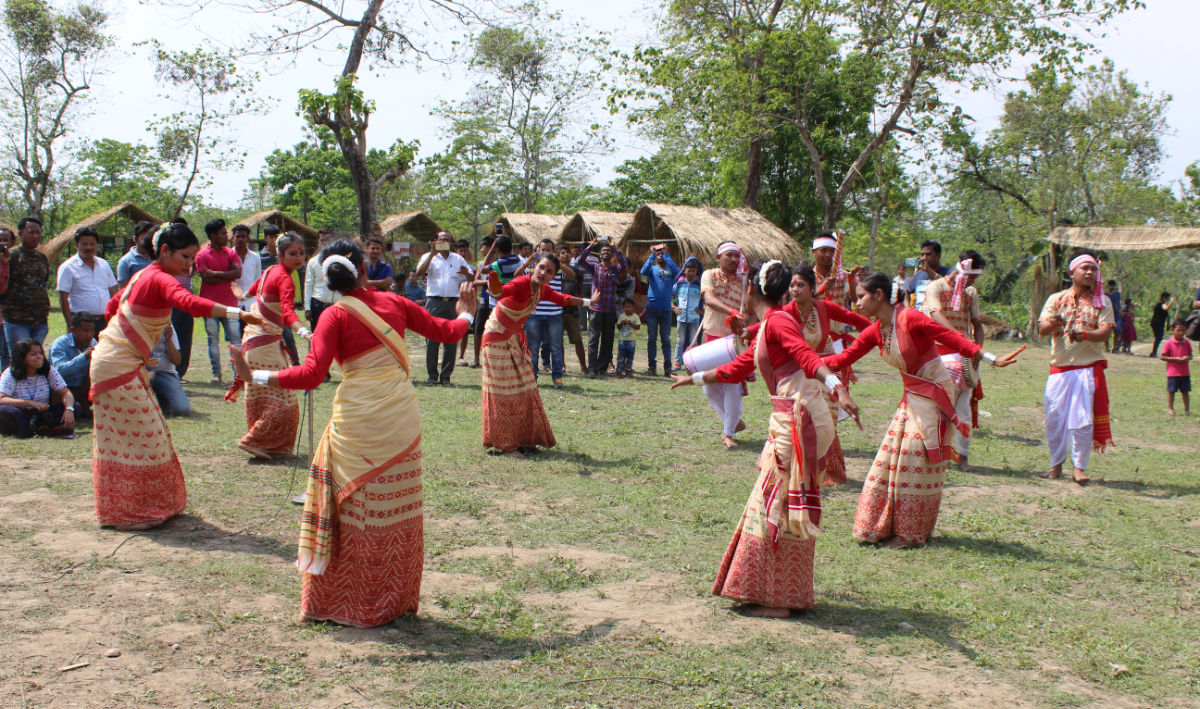
If we talk about dances in Indian states, Bihu dance is not only a folk dance of Assam but stands in the top ten folk dances of India. The Bihu Dance is a traditional dance form of Assam state, named after the famous Bihu festival. There are three Bihu festivals but Bihu dance is performed during ‘Rongali Bihu’. The festival is celebrated in mid-April every year during the Asssamese new year and the Bihu festival dance showcases the fertility of fields. It is more like celebrating the season with a harvest dance.
Traditionally Bihu dance is performed among the local farmer community mainly in fields, forests or at river banks. The exact details about the history of Bihu dance is not known but Bihu is considered as the start of Spring season in Assam. The group dance of Bihu is performed by both young males and females to show their joy of spring season arrival.
The Bihu dance involves rhythmic and energetic dance steps with quick hand movements. As for the dresses for dances goes, the male performers wear traditional dhotis and gamocha in bright colours while women wear traditional assamese attire- Chador and Mekhela for the dance. The music is a vital part of Bihu dance and instruments like Dhol, Pepa,Taal etc are used. The music instruments play the main role in any folk dance and it’s the same in case of traditional Bihu dance. Everyone dances to the tunes in beautiful and colorful attire sharing the joy of festival season.
The traditional Bihu dance is eye catching and it’s worth cherishing. If you happen to visit Assam, you can see the tribes performing this harvest dance at villages during Bihu festival.
*Recommended by Mayuri Patel of Fernwehrahee
Jhumur Dance
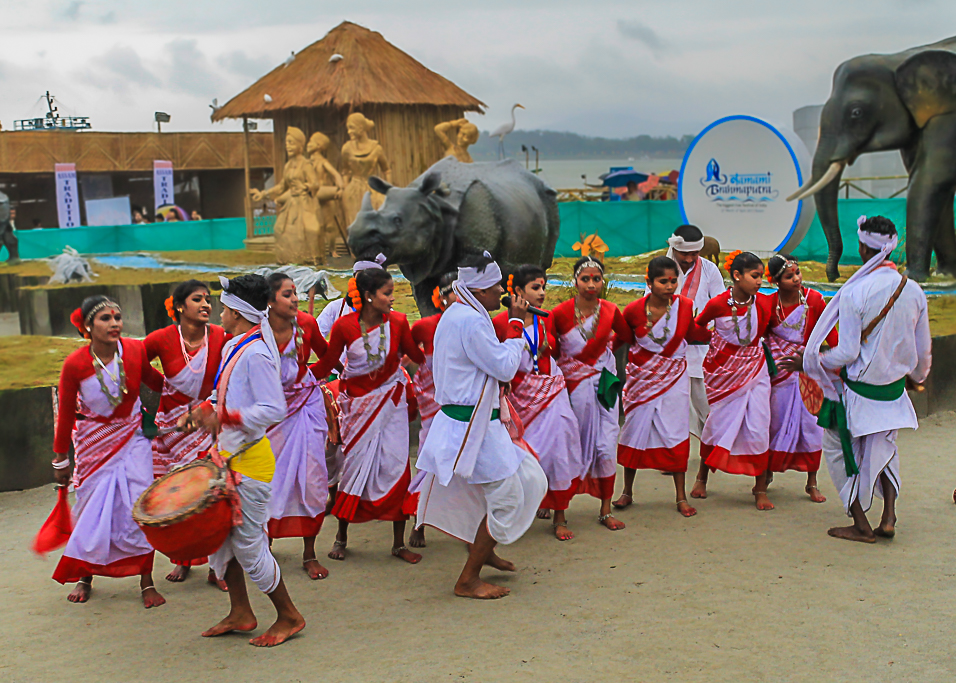
Another group dance of Assam is Jhumur dance. It is the clinking sound of the anklets worn by the dancers that gave this traditional folk dance of Assam its name – Jhumur. The dance is also, performed in some parts of West Bengal during the Autumn season. It does not just celebrate auspicious festivals like Karam Pooja but also, fills as a harvest dance in the idle time at the tea plantations.
Women clad in white sarees with red borders hold each other by hands or waist and move rhythmically to the beats of a traditional drum called Madal. The other musical instruments that are used in Jhumur group dance include flutes and Taal. The men usually wear long dhotis and join in with these musical instruments.
This is one of the best dances in Indian states. The beauty of this traditional dance of Assam Jhumur comes in from the perfect synchronization of not just the group dancing style but also, the way they move in tune to the beats of the Madal. The folklore dance theme revolves around everyday life. Sometimes, it also portrays a love dance of courtship and love. It is also, believed that Jhumur pleases the Rain God, who then showers his blessings on the various tea estates.
*Recommended by Ami Bhat of Thrilling Travel
Folk Dances of Gujarat
Dandiya Dance
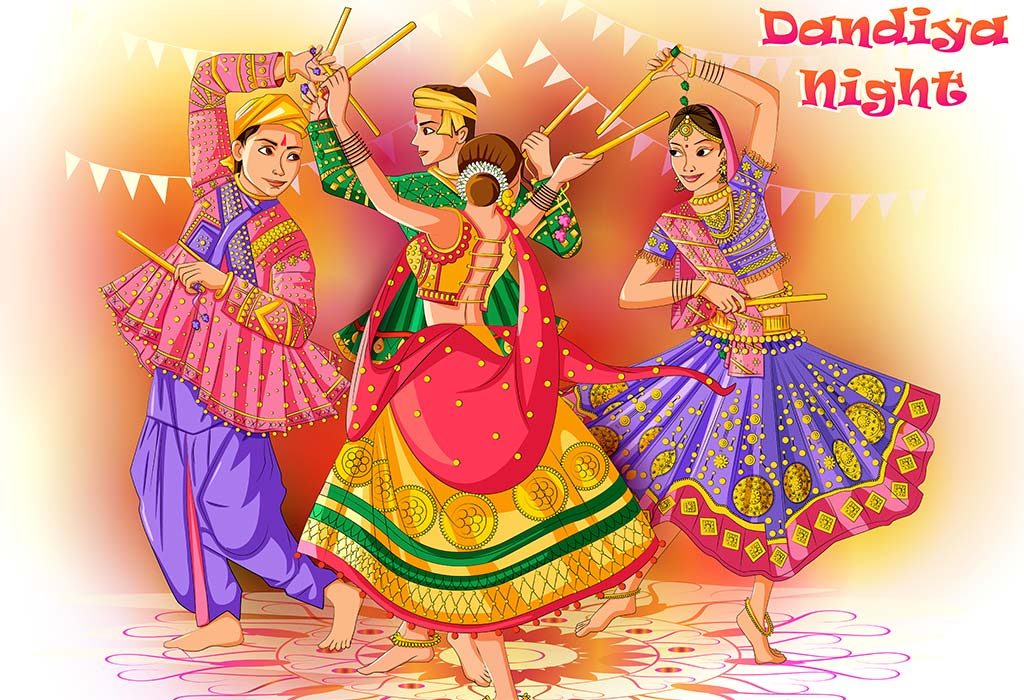
If you take names of Indian dances, Dandiya will probably come in top five. Dandiya dance or Dandiya Raas from Gujarat is one of the most popular Indian folk dances played during Navratri. Navratri symbolises the victory of good over evil and celebrates the spirit. Dandiya Raas is a way of that celebration in honor of Goddess Durga. Dandiya is the dramatization of a mock fight between the Goddess and Mahishasura – the mighty demon-king. The sticks (dandiya) used for Dandiya raas represent the sword of Goddess Durga. Hence, it also is nicknamed as “The Sword Dance”.
The dresses for Dandiya dancers is traditional attire comprising of multi-colored three-piece dress with a long skirt, blouse and bandhani dupatta for women, all heavily embroidered with colored threads, shells, beads and mirror work. Costume for men also is a heavily decorated jacket and dhoti.
The dance is performed in partners and they rotate during the dance. Dancers perform in a graceful and rhythmic manner on the beats of music in a circle as they circle around the ‘mandvi’. The movement is continuous.
Garba Dance
Folk Dances of Himachal Pradesh
Nati Dance
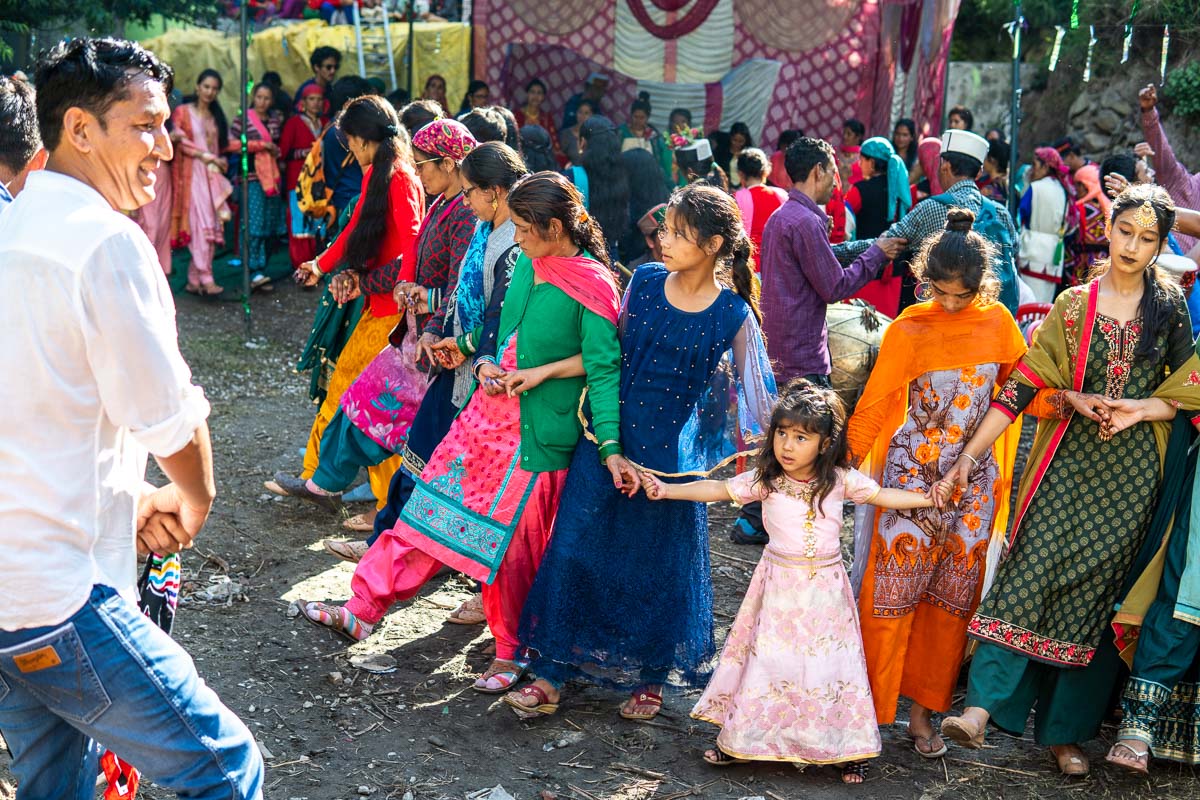
One of the folk dances of India is Nati dance. Nati is a traditional folk dance of Himachal Pradesh that is popular throughout the state. There are numerous versions of the dance, including the Kulluvi Nati, Shimla Nati, Lahuali Nati, Kinnauri Lati, and more.
The tradition is performed in large groups, participated in a competition of group dances and even broke the Guinness World Record for the largest folk dance in the world. This title was given after more than 9000 women danced Nati at once during a 2015 local festival.
Though women may have broken the world record, both genders can participate in this long-standing tradition, and in fact, it is believed to have originally been joined in by men only. One of the most notable features of Nati is that it is performed for days on end during weddings and other celebrations. It is one of the wedding dances in Indian states but is not a bridal dance. Dancers join hands in a crisscrossed fashion and move synchronically to the beats of dhol drums and trumpets.
Traditionally, men will wear white outfits and colorful, streaming headdresses while women will wear both colorful outfits and headgear. Since the dance is known to continue on for hours on end, some days of weddings and festivals will see dancers in more casual outfits.
There is no training for Nati, it is simply a unique Indian group dance that has been passed down through generations of Himachali locals, everywhere from Parvati Valley to Kalpa. If you want to see Nati performed up close (and perhaps get a chance to jump on into the group yourself), the easiest way to do this would be by attending a Himachali festival.
Since weddings are held randomly and wouldn’t be known about without local contacts, attending a celebration like Dussehra, which is held each October in Kullu, would be the perfect place to start. The massive annual event is where the world record was broken and is attended by tens of thousands from all over the state and the country. If you do plan to attend, be sure to book a hotel room early. These days, Dussehra even attracts international visitors and rooms can sell out.
*Recommended by Samantha Taylor of Intentional Detours
Folk Dances of Ladakh
Cham Dance
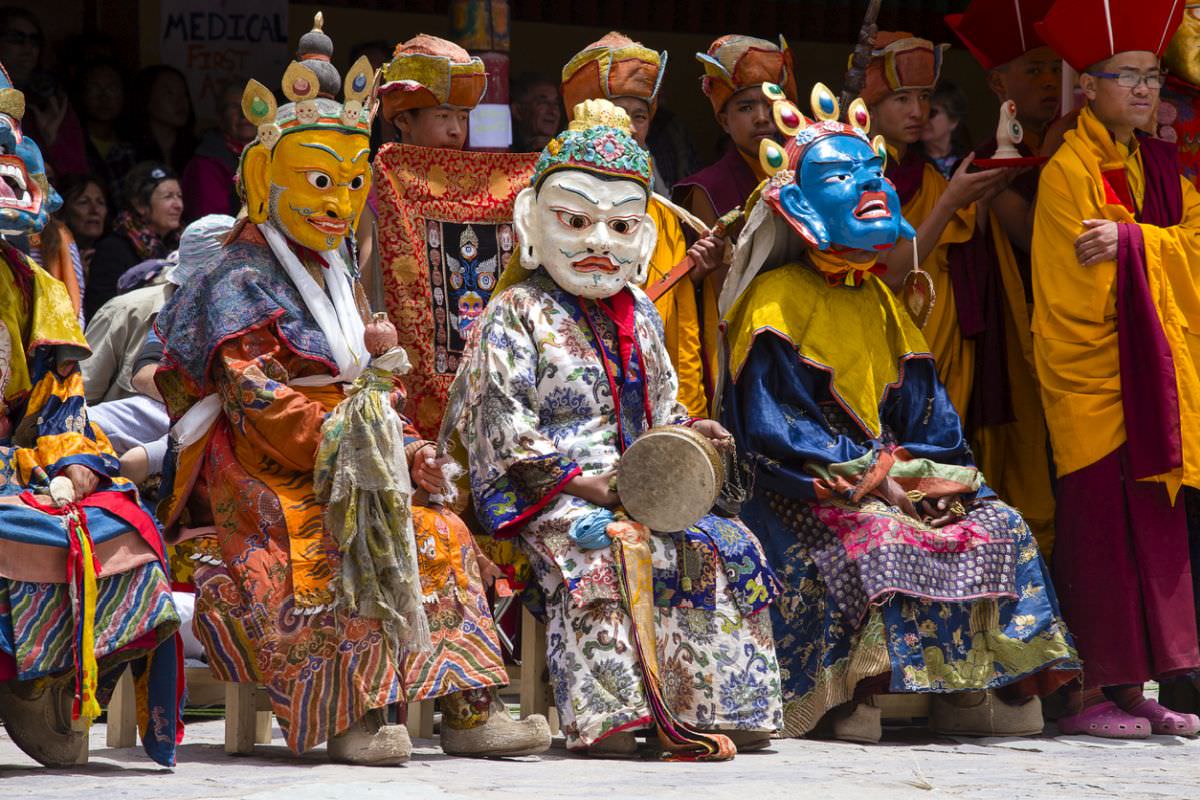
One of the popular dances in Indian states is the Cham dance is a vibrant mask and costume dance associated with some sects of Tibetan Buddhism. Cham has a religious significance, therefore, it is performed by only monks and lamas. It is a form of meditation for both dancers and the audience The music for the dance is played by the monks using traditional Tibetan percussion musical instruments such as cymbals. They also use Dramyin Cham, where time is kept using Dramyin. Generally, the leader of the Cham is a musician and guides the team of performers.
The colorful and impressive ritual is performed for the greater cause of humanity, destruction of bad spirits and for moral instruction to viewers. The dance also known as the ‘God Dance’. But the western world of 20th century has given it another name, derived from its costumes, …. ‘ Devil dance’. 🙂 During the dance, monks impersonate deities and protectors.
Cham Dance is a form of offering for performing Monks and is performed during religious festivals. This religious dance can be seen in parts of Himalaya, Ladakh, Dharamshala, Lahaul Valley, Spiti Valley & Sikkim, and Bhutan and Tibet.
Folk Dances of Manipur
Manipuri Raslila
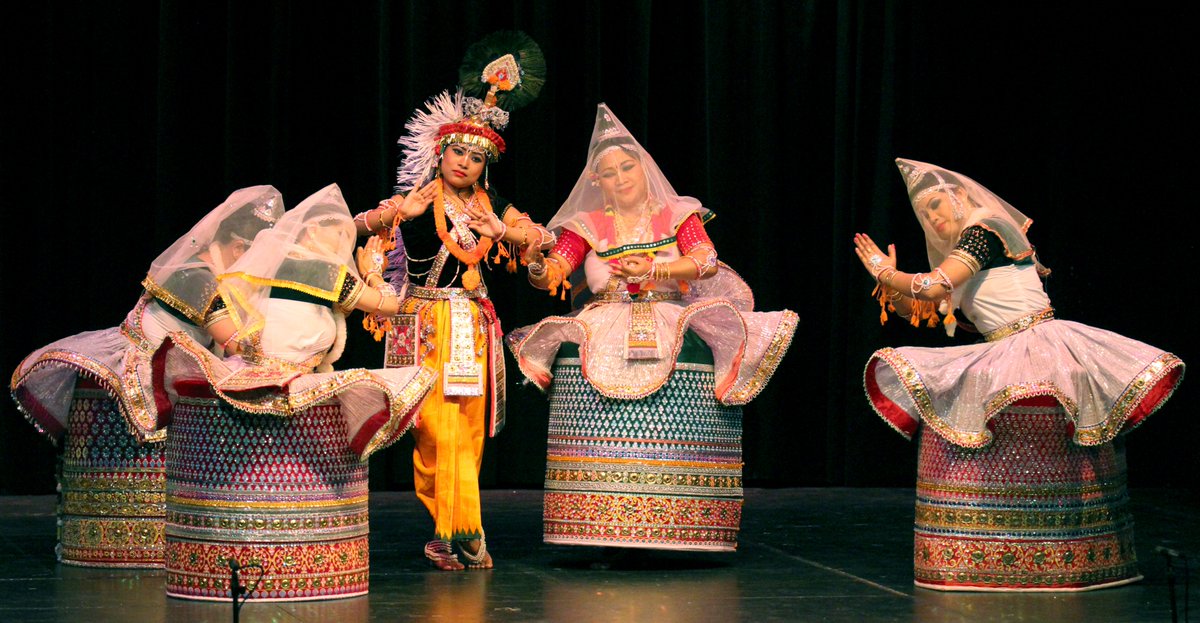
When it comes to traditional folk dances of India, one cannot forget to mention the Manipuri Raslila dance. The dance is native to the beautiful north-eastern state of India, called Manipur and occupies an important position not just in local Manipuri culture but in ancient Hindu culture as well.
Performed in the capital city of Imphal and its surrounding provinces, the Rasleela or Raslila dance is a subdivision of the Jagoi dance form. The particular Raslila dance is a tribute to the love story between Lord Krishna and his committed devotee Radha.
Raslila is one of the most graceful classical Indian dance forms whose corresponding music is mainly played on two instruments – flute and a Manipuri drum called Pung. The songs sung for the dance speak highly of the two lovers – Radha and Lord Krishna, and show a playful visualization of how they fell in love.
The dance has a rich history and finds references in the Vedic texts dating back to the 18th century. As for dresses for dances goes, what’s unique about the dance costume is, with the women wearing a Koktumbi attire with a Potloi cylindrical skirt with embellishments on it.
There are five types of Raslilas – with two performed in public and three performed in Shri Govindaji temple. The dance is performed by people belonging to the local Manipuri tribe “Meitei“, generally on the occasion of Krishna Janmashtami i.e. a festival celebrating the birth of Lord Krishna but you can also see the dance being performed in Manipuri weddings.
The group dance can be performed by both guys and girls so it isn’t gender specific. If you’re visiting Manipur during August, then don’t miss out on watching this elegant and beautiful dance form!
*Recommended by Vaibhav Mehta of The Wandering Vegetable
Folk Dances of Rajasthan
Chari Dance
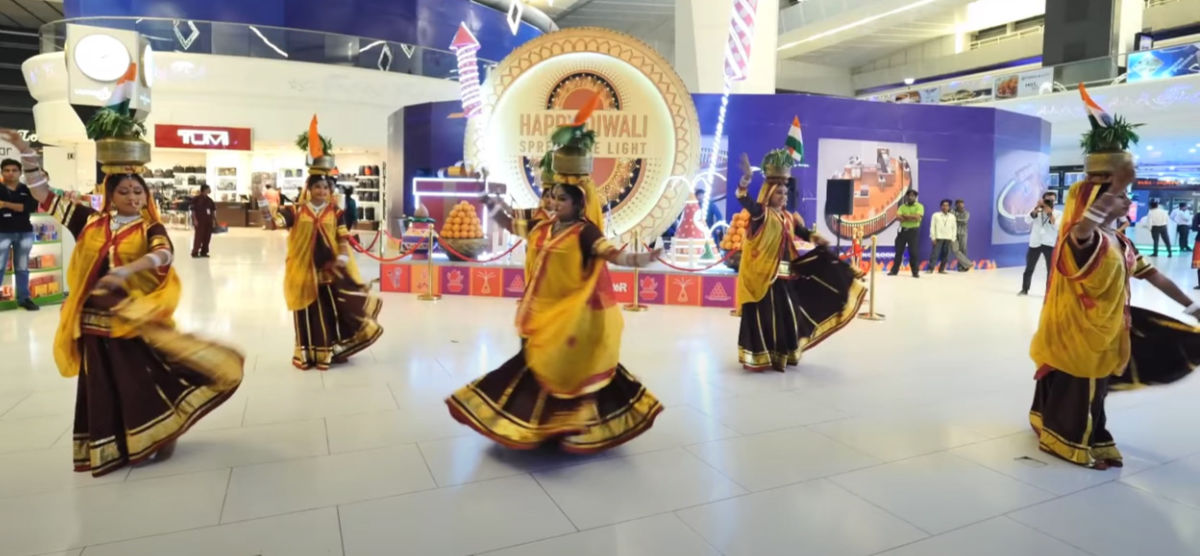
In a country with so many folk dances in Indian states, Chari from Rajasthan definitely stands out for many reasons. Named after the pots that the women hold over their heads, Chari Dance celebrates the art of collecting water by the Rajasthani women in a chari or pot in their daily life. The origins of this dance trace back to the Gujjar community in Kishangarh. And it’s a dance where only women perform.
The first thing that reaches out to you while watching a Chari performance is the powerful sound of dhol and bankia, an Indian music instrument. The background folk music also uses other instruments such as thali, harmonium and nagada.
Then one takes note of the colorful attire of the women, the assorted Rajasthani golden ornaments such as the big nose rings, Hansli, Timniya, Mogri. The women dance together to the music while balancing the flaming pots on their heads skilfully, without even touching the pots really. The flame is lit with a diya (oil lamp) or with cotton seeds immersed in fire.
In Rajasthan, the Chari dance is often performed in big festivals, and to celebrate marriage ceremonies and childbirth. If you are a foreigner visiting India, and you are in Rajasthan, chances are that it might be performed as a welcome dance in a hotel as well or in touristy places.
*Recommended by Deb & Claudia Rojas of The Visa Project
Ghoomar Dance

Another one of the famous folk dances in Indian states is Ghoomer. A famous traditional folk dance of Rajasthan, Ghoomer was originally performed by the Bhil tribe as a part of worshipping Goddess Saraswati. But then was adopted slowly by other communities in Rajasthan as well. And it can now be witnessed at several special occasions like wedding dance and festival dance.
While performing this dance, the ladies wear the traditional Rajasthani dress “Ghagahra” and put a long veil (called “Ghoonghat“) which covers their head and most part of their face. One of the main steps of this dance form is to move in circles and at the same time go round and round at high speed around an invisible circular circumference. Which requires exceptional stamina and balance on the dancer’s part. Not just that, since it is performed in a group, the dancers also have to pay attention that while performing the dance, they maintain the exact distance between themselves from the start to the end. The energy, rhythm and the balance is something that really sets this Ghoomar dance form apart. When performed synchronously in a group, with the traditional Rajasthani music & song in the background, it produces a beautiful and mesmerizing sight to behold.
One can have the pleasure of witnessing the Ghoomer dance performance by top local artists in Shilpgram – the artist village setup in Udaipur. The dance is also performed at several other tourist locations across Rajasthan at designated times of the day. If one is visiting the Bagore Ki Haveli Museum in Udaipur, or the City Palace of Udaipur, they can witness the Ghoomer dance performance there towards the evening. When visiting the Thar deserts of Rajasthan, one can witness small groups of local artists who entertain and perform the dance in the middle of the desert on tourist demand, thereby producing a beautiful and colorful scene in the middle of the golden sea of sand. Overall, it’s one of the most captivating and beautiful traditional dance forms of India.
*Recommended by Neha Verma of The Revolving Compass
Folk Dances of Uttarakhand
Choliya Dance
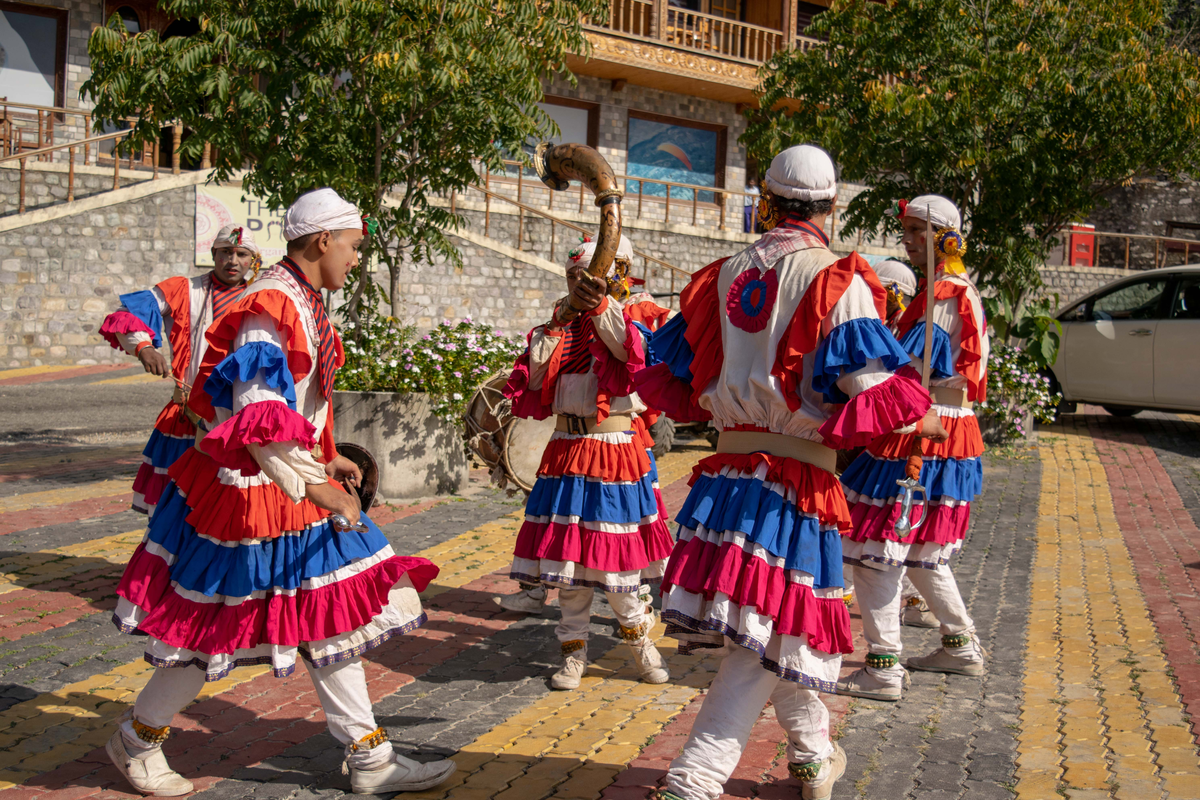
One of the popular folk dances in Indian states is Choliya dance. This dance form is practiced in the Kumaon region of Uttarakhand, Choliya Dance is a sword dance that is usually performed on auspicious occasions. This particular dance form is exceedingly popular in Almora, Pithoragarh, Bageshwar, etc. of the Kumaon region and is thousands of years old.
Earlier, this dance was performed at local Rajput weddings and has a religious dance significance. This dance is basically a folklore dance and is said to offer protection from demons and evil spirits. Marriage processions were considered the apt time for demons to follow the people and bewitch them. And performing Choliya Dance was the only way to prevent it and ensure that the marriage processions go without a hitch.
Since this dance is based on the martial art traditions of the Kumaon region, they play battle-like music and engage in synchronized mock fights as part of the dance. The dancers hold instruments such as swords, turhi, ransing, etc., they perform the group dance and give the impression of fiery warriors who are heading for battle. There are also musicians that hold dhols and dumaus to play the music while the dancers engage in a sophisticated routine.
What’s really interesting to note is their dress code for this performance. They wear traditional Kumauni attire including white churidar pajama, chola, taanka on the head, and sandalwood paste covering their face. They resemble the martial warriors that earlier stayed in the Kumaon region and it is a privilege to watch them perform this Sword dance. Best way to reach Uttarakhand from Delhi is to take a road trip.
*Recommended by Rachita Saxena of Meander Wander

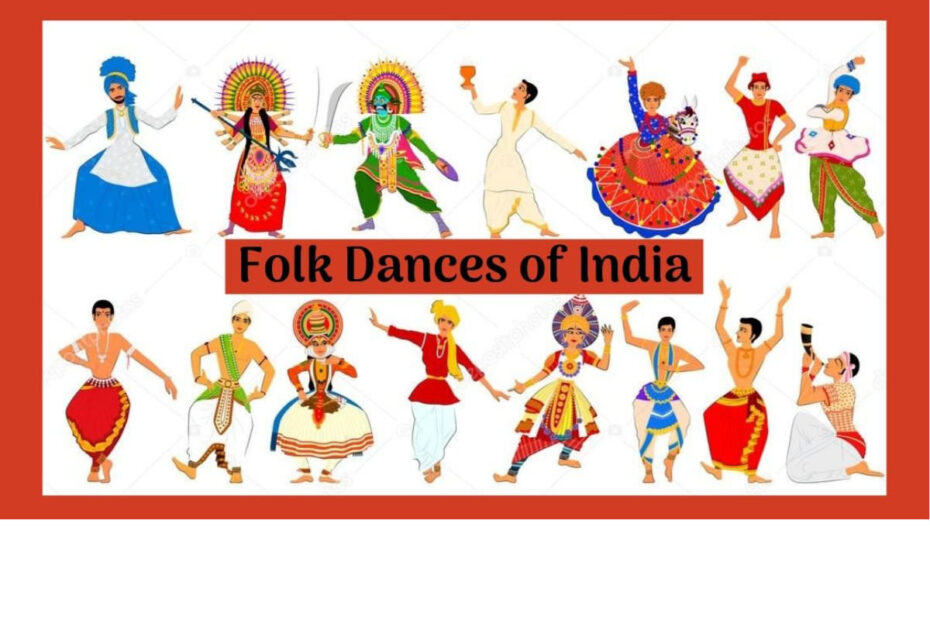
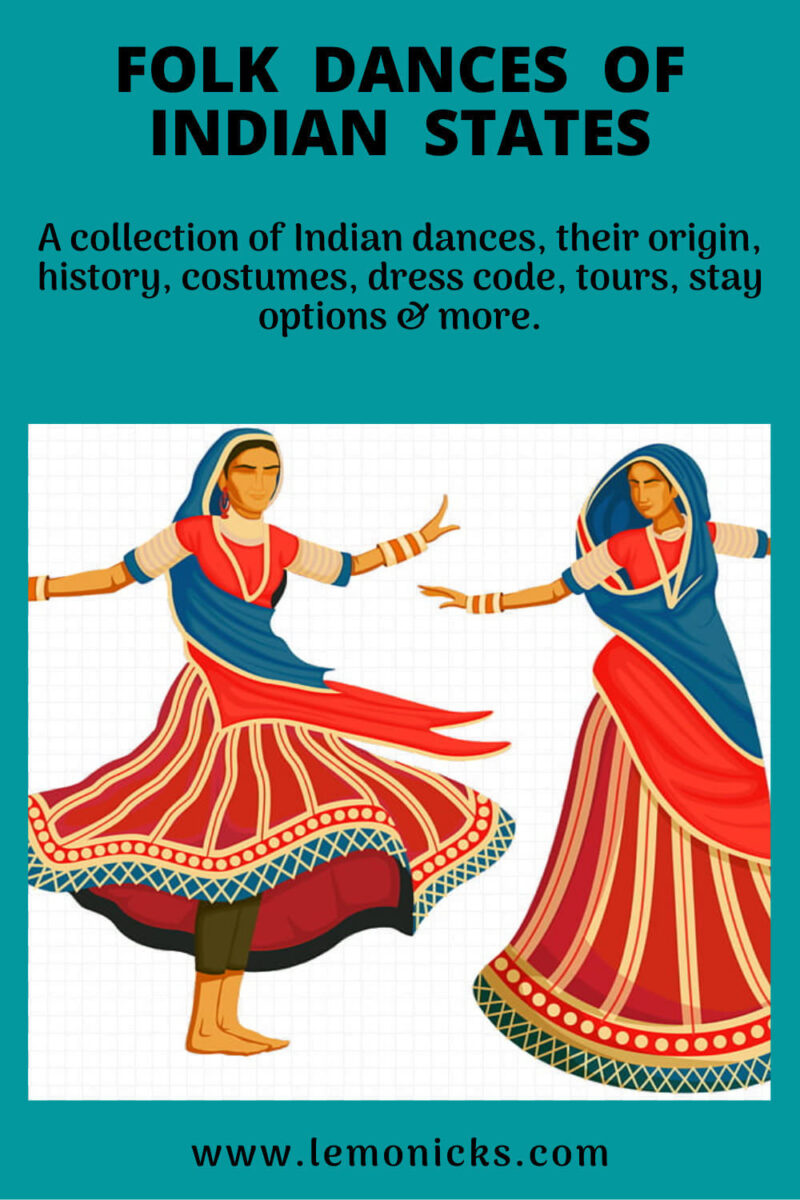
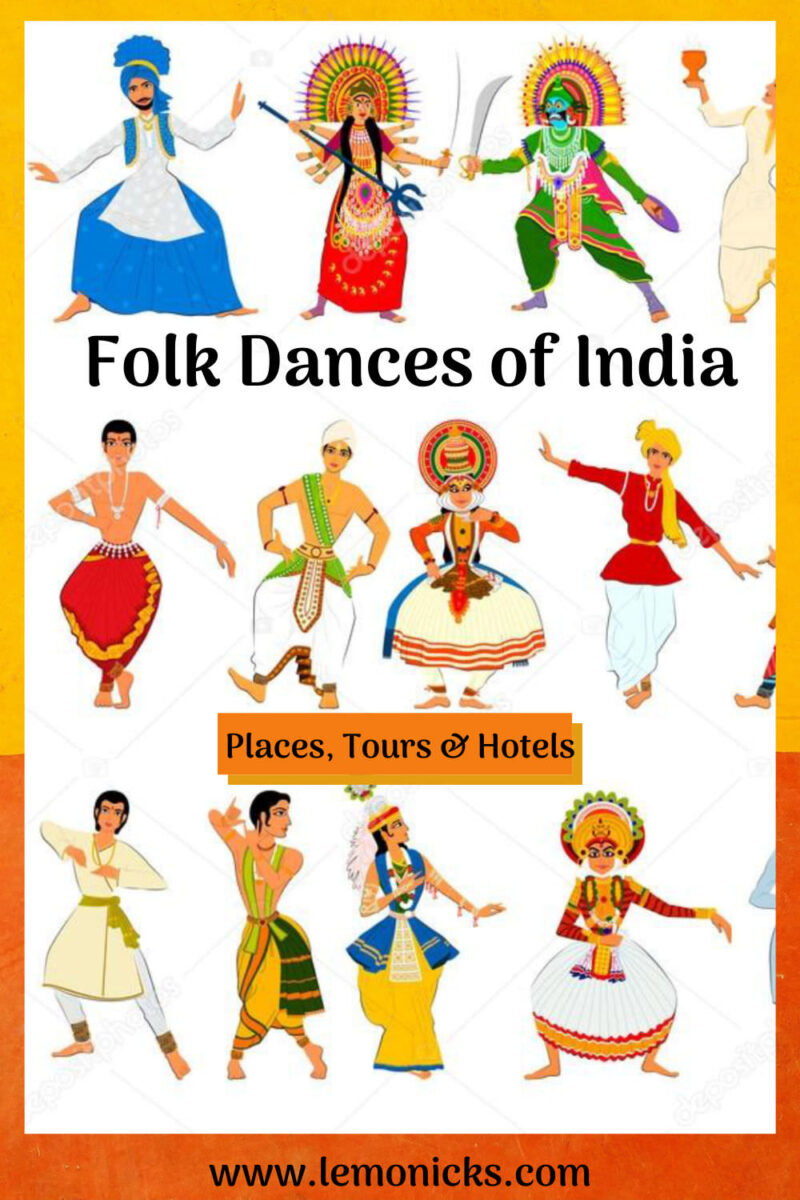
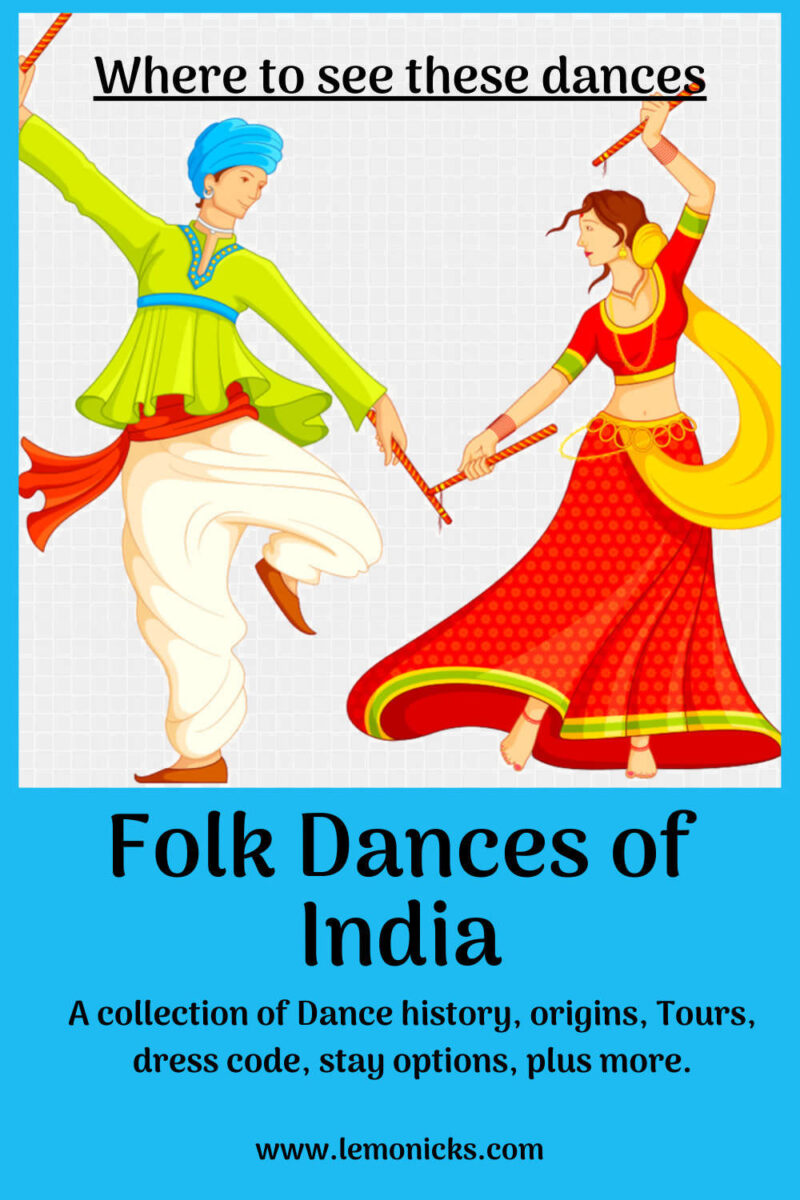

This came out so well.. Love reading it. Pinned the Post.
Thank you mam once again.
Thank you. 🙂
This post actually makes me proud of how vivid Indian culture is.
Unfortunately, for me, I have only witnessed one type of dance yet and that is Chari dance. And I must say that it was a lifetime of experience.
Also, very good with the writing part. Please keep posting.
in uttarakhand Barada Nati folk dance is a popular dance of Jaunsar Bhawar area of Chakrata Tehsil in Dehradun district. it’s really fabulous place
Wow. Such a culturally beautiful post this is. Loved to know about the different dance forms of our country
Good information to read. This post is very effective and the images also helping us to understand your point. Thank you share this. superb post, we enjoyed each and everything as written in your post. Thank you for this article because it’s really informative, I love reading your blog.
It was nice reading your blog. Marvelous work!. A blog is brilliantly written and provides all necessary information I really like this site. Thanks for sharing this useful post. Thanks for the effective information.